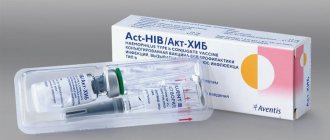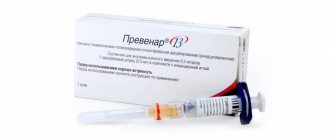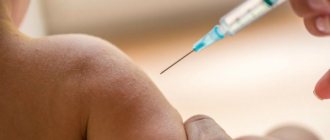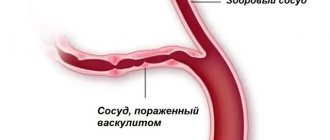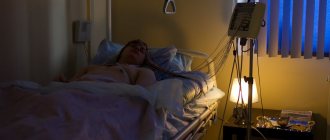What is angina and why does it occur?
To help a patient with an attack of angina, you should know what this condition is and what are the reasons for its development. Angina pectoris is a clinical syndrome accompanied by sudden and acute pain in the sternum due to impaired blood circulation in the coronary artery. Previously, this symptom was called “angina pectoris,” but now this concept is outdated.
The main cause of the pathology is a disruption of blood flow through the vessels due to the formation of atherosclerotic plaques on their walls. The following provoking factors lead to this:
- bad habits (smoking, alcohol, drugs);
- hypertonic disease;
- increased blood cholesterol levels;
- poor nutrition;
- sedentary work, lack of physical activity;
- excess body weight;
- diabetes;
- anatomical aging of the body;
- frequent stress;
- metabolic disorder.
Together with hormonal disorders, changes in blood composition and many other reasons, these factors provoke the development of diseases of the heart and blood vessels, the symptom of which is angina pectoris.
How to recognize an attack
First aid for angina pectoris should be provided in a timely manner. To do this, it is important to know how an attack manifests itself. In this condition, the patient experiences symptoms such as burning, sharp pain in the sternum. Sometimes it spreads to the area of the collarbone, shoulder blade, and neck.
Chest pain and shortness of breath often indicate an attack of angina.
You can suspect angina in a person if you have the following symptoms:
- pale facial skin;
- jump in blood pressure;
- abnormal heart rate;
- dyspnea;
- cold sweat;
- nausea, less often vomiting;
- headache.
The duration of this condition usually lasts a few minutes, but sometimes the pain lasts longer. In some patients, the attack goes away on its own, but despite this, these symptoms cannot be ignored. Often, prolonged angina leads to the development of myocardial infarction. If an attack is detected, the patient should be provided with emergency assistance.
In what cases is Nitroglycerin contraindicated during an attack of angina?
The patient or his relatives should be aware that if signs of low blood pressure are detected (with collaptoid angina), taking drugs from the group of organic nitrates (Nitroglycerin, Isoket, etc.) is contraindicated. The following signs may indicate hypotension:
- the patient experiences severe weakness;
- dizziness;
- pallor;
- cold sweat.
In such cases, the sequence of actions should be as follows:
- Lay the patient down.
- Call an ambulance.
- Give him a crushed Aspirin tablet.
- To reduce pain, you can use tablet analgesics (Baralgin, Sedalgin, etc.).
First aid to a patient
First aid for angina pectoris should be provided at home before doctors arrive. In this case, the algorithm of actions is as follows:
- Provide the person with complete physical and emotional peace. This will help relieve excess stress from the myocardium.
- The patient should take a horizontal position with his head elevated. You need to let fresh air into the room. Clothes should not restrict the victim; to do this, unfasten the belt and collar. It is important to avoid crowds if the attack occurs on the street.
- If the state of rest does not bring relief, you need to give the patient a Nitroglycerin tablet under the tongue. Usually one or two tablets help achieve the desired effect, but in particularly severe cases, 4-5 tablets may be needed.
- It is recommended to reduce blood pressure using antihypertensive drugs. The victim should be asked if he is taking any medications to lower blood pressure.
- Often during an attack, the patient is worried about fear for his life, so it is allowed to give him any sedatives (tincture of motherwort, valerian and others).
First aid must be correct and timely
Important! If the pain does not go away within 10–15 minutes after re-taking Nitroglycerin, you should call an ambulance.
Coronary heart disease (CHD), or angina (questions and advice for the patient)
Coronary heart disease is a disease that occurs due to insufficient blood supply to the heart due to narrowing of the lumen of blood vessels. Pain during angina appears most often in the center of the chest, but it can also be on the left, in the region of the heart, and can radiate (“give”) to the neck, lower jaw, left arm, between the shoulder blades. The sensation may be squeezing or pressing. Some patients feel as if something is falling on their chest. Sometimes, along with the pain, there is a feeling of lack of air, the inability to breathe. Angina almost always appears during stress - physical or emotional. It can begin during fast walking, running, climbing stairs, lifting heavy objects, or during severe stress or emotional distress. In later stages, when the disease becomes more severe, pain may also occur at rest. It is very important that if such sensations occur, be sure to consult a doctor as soon as possible!
What you need to know about coronary heart disease?
In order to function properly, the heart needs oxygen and nutrients. The blood supply to the heart is carried out through the arteries that surround the heart, like the crown, and are therefore called coronary. Blood enters the coronary arteries from the aorta, after which it is delivered through smaller vessels to the working myocardial cells. The diameter of the coronary arteries is very small - they are no thicker than a cocktail straw (3-5 mm), but disruption of their patency can cause serious damage to health. The main cause of impaired arterial patency is atherosclerosis (from the Greek words “ather” - gruel and “sclerosis” - hardening). The name accurately reflects the essence of the process - the accumulation of soft deposits on the walls of the arteries - lipids (fats, such as cholesterol), the subsequent proliferation of dense connective tissue and hardening - calcification. As a result, the arteries lose their elasticity and become stiff. Lipid (fat) deposits, called atherosclerotic plaques, bulging into the lumen of blood vessels lead to narrowing of the lumen or even blockage of the arteries. The mechanisms of the early stages of the development of the atherosclerotic process, due to which plaques and narrowing of the coronary vessels develop, have not yet been fully clarified. Nevertheless, today it has been proven that atherosclerosis develops, among other things, in response to damage to the vascular wall from the inside (damage or dysfunction of the endothelium). This can be caused by a number of reasons, in particular, smoking, a significant increase in blood lipid (cholesterol) levels, high Blood Pressure, psycho-emotional stress, viral or bacterial infection. Hereditary predisposition also plays a role. Narrowing (stenosis) of one or more coronary arteries by atherosclerotic plaque(s) reduces the supply of blood and oxygen to the heart muscle and causes myocardial ischemia (from the Greek words “ishe” - retain and “hemo” - blood). It is the lack of blood and oxygen that causes the pain a person feels during an angina attack.
What is angina and how to recognize it?
Angina pectoris is the main symptom of chronic coronary heart disease (CHD)
Angina is an acute feeling of discomfort in the chest (a feeling of squeezing, tightness, burning, pain), forcing a person to stop physical activity. Regardless of what kind of exercise causes angina, the attack should go away after stopping the exercise and/or taking nitroglycerin (spray or tablets). If the discomfort in the chest does not go away after this, immediately call an ambulance; a myocardial infarction may develop.
If any unpleasant sensations appear in the chest, you should consult a doctor for a routine, “standard” (ECG, blood tests, medical examination) or more in-depth examination (ECG or echocardiogram with stress, ECG monitoring throughout the day, coronary angiography of the arteries of the heart) . Coronary angiography is performed for severe manifestations of angina pectoris in order to clarify the possibility of using surgical methods to improve the blood supply to the heart, stenting or bypass surgery. (see more detailed information on “poststenta.rf”).
What to do if you have an angina attack?
Angina is a cry from the heart for help. Although an insufficient amount of blood flows through the heart artery narrowed by the plaque, under resting conditions it is enough to provide the heart muscle with oxygen supplied by the blood.
Therefore, the first action for angina pectoris is to stop the load that caused the attack. Second action: if the attack does not go away within 2-3 minutes with rest, you need to take 1 tablet of nitroglycerin, placing it under the tongue. It is more convenient to use nitroglycerin in the form of a spray. Nitroglycerin is quickly absorbed, enters the blood and causes dilation of the blood vessels of the heart. After 1-2 minutes the attack should stop. Short-term attacks of angina go away on their own when you stop exercising or after taking nitroglycerin for 2-3 minutes, sometimes up to 8-10 minutes.
Remember! You should always have an adequate supply of your medications with you!
With coronary heart disease (more precisely, with atherosclerosis, which narrows the arteries of the heart), myocardial ischemia occurs (bleeding of part of the heart muscle) of varying durations - from several minutes to 1 hour or more.
Ischemia for more than 40 minutes is most likely associated with the development of arterial thrombosis (blockage by a blood clot). This is a sure sign of a beginning or already occurring myocardial infarction (death of cells of part of the heart muscle).
What to do in this situation?
At the first sign of a heart attack, call 911. It is best to start treatment within the first hour after symptoms appear. Waiting increases heart damage and reduces the chance of survival. It is essential to prevent the artery from narrowing within 90 minutes to minimize the consequences.
Before the ambulance arrives, provide access to more oxygen: unfasten the collar, open the window.
Be sure to stop any physical activity, lie down with the head of the bed raised or sit in a chair with armrests, and relax as much as possible.
Do not eat, do not drink, do not smoke.
If pain persists, continue taking nitroglycerin every 7-10 minutes. If there is no pain, you do not need to take nitroglycerin.
Do not panic! Emotional stress can further increase ischemia.
Strictly follow the recommendations of the emergency doctor after an attack.
How to deal with angina pectoris?
It has been proven that modern treatment methods can prevent the progression of the disease, prolong life and maintain health.
To do this, first of all, it is necessary to change your lifestyle and give up bad habits, eliminating risk factors:
If there is hypertension, the blood pressure level should be brought to figures less than 130 mm. Hg / 90 mm. rtst.
Quit smoking
Stop drinking alcohol
Monitor your diet using a diet for patients with coronary artery disease
Get rid of excess weight
Consult your doctor for recommendations on physical activity
Non-drug methods (diet, physical training, blood pressure control, weight control) significantly increase the effectiveness of drug therapy. But the persistence of risk factors such as smoking, alcohol, hypertension, excess weight, low physical activity, and diabetes mellitus can reduce the effect of drug prevention!
What medications should be taken to relieve angina attacks?
Once you are diagnosed with angina, you may need to take medications indefinitely, long-term. Even if you have had coronary angioplasty (sometimes called PCI, PTCA, stenting) or coronary artery bypass grafting, you will need to continue taking your medications afterwards.
To reduce the number of angina attacks, there are a number of drugs called antianginal drugs.
Remember that prescribing, discontinuing and changing dosages for the treatment of angina pectoris is carried out only by your attending physician .
The purpose of these drugs is to prolong your life and eliminate (or significantly reduce) the symptoms of angina pectoris. Symptoms will decrease due to normalization of blood flow, pressure, pulse, and restoration of the metabolic state of heart cells.
What can the doctor prescribe for you? (only if indicated and after examinations!).
Fast-acting nitrates (spray or tablets).
These drugs are used to relieve angina attacks. The essence of their action is that they quickly dilate the blood vessels of the heart, which relieves pain. You should always have nitroglycerin spray (or tablets) with you. This could save your life. But remember that these drugs only relieve the symptoms of angina pectoris, but do not cure it. If you take them often and regularly, their effect may weaken. Be sure to tell your doctor how many times a day/week you use nitrates.
Beta blockers
They act on the sympathetic nervous system, somewhat slow down the heart and lower blood pressure. It is very important to take them constantly, for a long time, and under no circumstances stop taking them without consulting your doctor. Beta blockers are used to prevent angina attacks, but not to relieve them.
Calcium antagonists
They also prevent the development of angina attacks. Taking these drugs leads to dilation of the arteries, including the arteries of the heart. As a result, blood flow improves, the load on the heart decreases, and more blood flows to the heart. Calcium antagonists also lower blood pressure.
Myocardial cytoprotectors
These drugs have a fundamentally different mechanism of action. They prevent the development of attacks by influencing metabolic disorders caused by a lack of oxygen directly in the heart cells.
Without affecting blood pressure and pulse, these drugs enable the heart to work without ischemia by switching the heart to more economical use of scarce oxygen. They switch metabolic processes to use glucose as “fuel” for the heart, rather than fatty acids as is usually the case. With the same amount of work, the heart requires less oxygen (by about 20-30%) to oxidize (burn) “fuel” for the normal functioning of heart cells
If after your doctor prescribes/discontinues any pills you feel worse, do not make any independent adjustments to your treatment, but, if possible, contact your doctor as quickly as possible.
What to tell the doctor
Describe how you feel. Fill out the form on the back.
Show your blood pressure and heart rate monitoring diary.
Tell us in detail about the pain - where it hurts, what it is like, when it occurs, how you relieve it.
If you have had any examinations or tests, bring the results to your doctor.
What to ask your doctor
Do I need to take medications? When? How many times a day? What dosage?
When to come next time?
What to do if it gets worse?
Do you need a diet? Which? How much fluid to drink?
Are there any restrictions on physical activity?
It is important to control angina pectoris
Note how you feel in your diary every day, this is very important for controlling angina.
Download the Angina Control mobile application from the AppStore or GooglePlay. It is easy to use and will help you better evaluate the effectiveness of therapy.
Information for patients.
Fill out the questionnaire before your doctor’s appointment; this will make communication with a specialist more effective.
Gracheva Z.M. — cardiologist OGBUZ ARB
Print Email
- Back
- Forward
Recommendations for the use of Nitroglycerin
Nitroglycerin is the medication most often used during emergency treatment for angina. The drug reduces the myocardium's need for oxygen, restores its transportation to all parts of the heart, eliminates coronary artery spasm, and has an analgesic effect. The peculiarity of the medicine is that after 45 minutes it is completely eliminated from the body.
To provide first aid to a patient during an attack, medication in the form of tablets, drops or capsules is usually used. Depending on the form of the medicine, you need to take it as follows:
- The tablet or capsule is placed under the tongue. It needs to be absorbed until completely dissolved;
- Drops drop onto a piece of sugar or bread (2-3 drops) and place under the tongue. If you don’t have sugar on hand, you can simply drip the medication under your tongue.
Some patients do not tolerate Nitroglycerin well. For them, it is recommended to take drops containing this component, as well as tincture of belladonna, lily of the valley or menthol. This helps reduce discomfort in the form of headaches after taking Nitroglycerin. One dose – up to 15 drops of the product.
People who are prone to a sharp decrease in blood pressure should take this drug with caution. The product may cause severe headache, weakness, and nausea. Patients suffering from glaucoma or who have suffered an acute disturbance of blood circulation in the brain area should take Nitroglycerin only as prescribed by a doctor in a limited dosage.
Nitroglycerin should be in every first aid kit
If the medicine described is not in your medicine cabinet, you can take Phenigidine, Captopres or any other antihypertensive medicine. Immediately after the pain has subsided, you should not get out of bed; it is recommended to lie down for another 15–20 minutes until you feel completely restored.
Algorithm of actions for a prolonged attack
Emergency care for an angina attack that cannot be relieved with Nitroglycerin is provided in a hospital setting. In this case, the scheme has the following character:
- Nitroglycerin under the tongue with simultaneous intravenous administration of glucose solution and non-narcotic painkillers;
- administration of antihistamines (Diphenhydramine) and tranquilizers (Seduxen);
- taking Aspirin in effervescent form.
If there is no effect, narcotic analgesic drugs (morphine hydrochloride, Promedol) are administered within 10 minutes, which are combined with a neuroleptic and a tranquilizer.
After normalization of the patient's condition, echocardiography is mandatory. This is necessary to diagnose a possible myocardial infarction.
Help with myocardial infarction
Competent first aid for the development of myocardial infarction is the key to its successful treatment and prevention of many dangerous consequences. A heart attack is a severe condition accompanied by necrosis of individual areas of the myocardium. Emergency diagnosis of such a condition in a patient includes an assessment of his well-being and the presence of certain symptoms. Laboratory blood testing is valuable, which allows us to identify the presence of markers formed in the blood during the development of a heart attack. Among the clinical manifestations, the following signs indicate a heart attack:
- pain syndrome localized behind the sternum, spreading to the area of the arm, shoulder blade, neck and jaw;
- the duration of the attack is more than 2 hours, which makes it possible to differentiate this condition from angina pectoris;
- the appearance of nausea, vomiting, fainting;
- lack of effect after repeated administration of Nitroglycerin;
- development of cardiogenic shock, coma.
An ECG helps confirm or refute a heart attack. Necrosis is characterized by such changes on the electrocardiogram as displacement of the ST segment (it exceeds the isoline), as well as deformation of the Q wave.
Each of the subsequent actions during treatment is carried out in the absence of a therapeutic effect from the previous one. The algorithm for providing assistance in case of a heart attack is as follows:
- solution of Omnopon, Droperidol or Diphenhydramine through a dropper for 5 minutes in combination with saline solution. In parallel, acetylsalicylic acid orally;
- Fentanyl is used to lower blood pressure. The dosage is selected individually, depending on blood pressure;
- therapy aimed at dissolving blood clots and preventing their formation using beta-blockers;
- Nitroglycerin solution (1 ml per 100 ml of physiological solution). The medicine is administered with constant monitoring of blood pressure at a rate of 25 mcg/min. If the dose is well tolerated, the doctor increases the drip rate by 10 mcg every minute.
Treatment of myocardial infarction is carried out in an inpatient setting
When respiratory function is depressed, oxygen therapy is used. Inhalation using nitrous oxide and pure oxygen. Throughout the entire period, respiration, blood pressure, pulse and other vital signs are monitored. If necessary, analgesic drugs are reintroduced.
Important! The most favorable prognosis for the patient is possible if medical care was provided within the first 72 hours after the development of myocardial infarction.
Methods for diagnosing angina pectoris
Treatment of angina begins with diagnosing the condition of the coronary vessels. For this purpose, procedures such as:
ECG
Electrocardiography (ECG) is a basic diagnostic procedure in cardiology. Patients with angina pectoris are also recommended to undergo daily ECG monitoring.
More information about the diagnostic method
Treadmill test
Exercise tests such as the treadmill test and bicycle ergometry are also widely used to diagnose heart conditions.
More information about the diagnostic method
Echocardiography
If cardiac abnormalities are detected, echocardiography (ultrasound of the heart) is performed.
More information about the diagnostic method
Coronary angiography
The condition of the coronary vessels is determined by coronary angiography (x-ray examination of the heart vessels with the introduction of a contrast agent).
More information about the diagnostic method
Blood chemistry
Laboratory diagnosis of angina pectoris involves, first of all, a biochemical blood test. Indicators such as cholesterol, hemoglobin, AST, ALT, and other indicators are assessed.
More information about the diagnostic method
Sign up for diagnostics To accurately diagnose the disease, make an appointment with specialists from the Family Doctor network.
